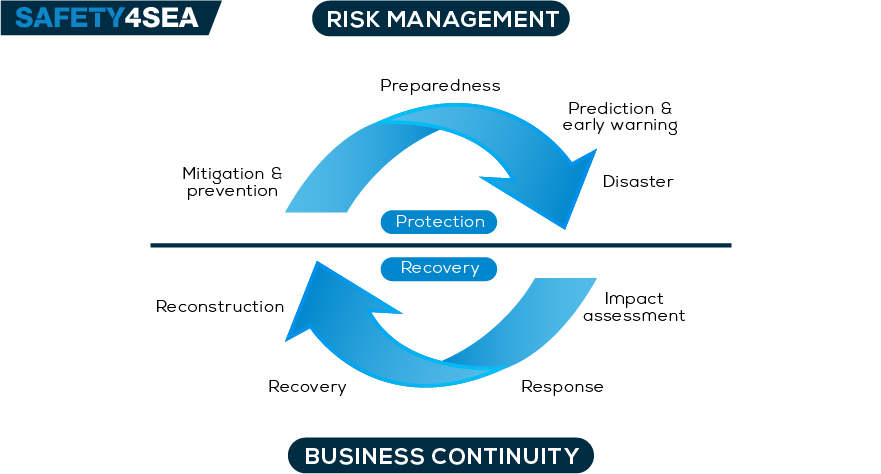20 April 2010: The explosion of the BP Deepwater Horizon oil rig in the Gulf of Mexico causes the largest maritime disaster oil spill in the USA history and subsequently considerable reputation and financial losses to BP followed by ineffective tactics and tools used by the company to communicate with stakeholders during and after the crisis.
Numerous shipping organizations have faced similar disruptive events having a negative impact to their reputation within the industry. Others have failed to understand how employees are perceiving the shipping world, providing poor information on potential hazards that could bring catastrophic impacts. Why is this happening? Either, because crisis communication strategies are not in place, or because decision makers are not giving the attention needed to them; in other words, this is the aftermath of crisis management failure.
It is not coincidence that, in many other industries several crisis communication strategies have failed because leaders are coordinated by psychology “myths” rather than the reality of how their employees and people in general perceive the world. A good way to understand this is to analyze the concept of crisis management and communication and their importance in the maritime world.
What is crisis management?
The term crisis management refers to the process by which an organization deals with an unexpected event that threatens to harm the organization in general or its stakeholders in particular. Specifically, there are 4 crisis elements:
- the threat to the organization
- the element of surprise
- the short decision time
- the need for change
“Crisis is a process of transformation where the old system can no longer be maintained,” Steven Venette writes
In other words, in case that change is not needed, the event could be described as a failure or crisis incident.
Crisis management VS Risk management
At this point it is important to mention that risk management is about assessing potential threats and finding the best ways to avoid them, while crisis management involves dealing with threats before, during, and after they have occurred. The three phases in any Crisis Management are:
- The diagnosis of the impending trouble or the danger signals.
- Choosing appropriate Turnaround Strategy.
- Implementation of the change process and its monitoring

The importance of crisis communication
Crisis communications strategies aim to influence how people respond, think and feel about a situation. Indeed, more than facts are needed to convince your employees. Crisis communication is the tool to protect the reputation of an organization and maintain its public image. Therefore, a crisis communication process can be described as follows:
- Discuss the problem with employees
- Don’t criticize individuals
- Encourage effective communication at the workplace during emergency situations
- Respond quickly and effectively during unstable situations
- Make sure information is kept confidential
- Evaluate performance of employees on a regular basis
What can be a crisis situation in shipping?
The presence of both internal and external vulnerability within systems increase the vigilance needed within an organization. In year 2018, shipping industry is threatened by many crisis concepts potentially caused by:
- cyber security incidents
- piracy incidents
- serious accidents (i.e collisions/ oil spills) & fatalities
- maritime trading systems’ failures
- economic problems or even bankruptcy incidents etc.
5 Ways to handle a crisis in a shipping organization
- Have a trained and responsive crisis management team
- Ensure robust threat assessment capability
- Conduct consequence analysis to understand how multiple impacts may occur
- Have crisis management decision-making capacity
- Have communication mechanisms for reporting emergent issues to the CEO and senior management (Barnes, 2001).
A Best Practice Example
The most challenging latest major disaster was the Cyber Breach in MAERSK during 2017. At the end of June 2017 MAERSK was subject of a cyber attack which caused major problems to operations and terminals worldwide. A computer virus, called GoldenEye or Petya, began its spread on Tuesday 27th June 17 in Ukraine and affected companies in dozens of countries. The virus entered into system as an employ answered an unidentified mail by clicking. Several port terminals run by a Maersk division, including in the United States, India, Spain, the Netherlands, were struggling to revert to normal operations after experiencing massive disruptions. Dry cargo could not be delivered and no container would be received. Several IT systems were shut down and MAERSK paid almost $300m as cost of operations suspension and cargo damages. Cost of systems upgrading and additional protected measures cannot be calculated yet. What was the reaction of the Company?
Firstly MAERSK issued an announcement with confirmation of the incident. The wording used for Company’s reaction was “We continue to assess and manage the situation to minimize the impact on our operations, customers and partners from the current situation. Business continuity plans are being implemented and prioritized. The aggregate impact on our business is being assessed.” The Top management involved directly to Crisis Management as Group’s CEO states in his interview 2 months after the incident. Then response axis had three elements:
- Get deep in CEO participated in ALL crisis calls and meetings…..
- Focus on internal and external Communication. Maersk sent out daily updates detailing which ports were open and closed; which booking systems were running and more. It also constructed a makeshift booking service from scratch.
- Provide clear Guidance. Company made sure that frontline staff in the 130 countries it operates in, were able to “do what you think is right to serve the customer — don’t wait for the HQ, we’ll accept the cost”.
Conclusion
Either you prepare, or you indulge in damage…Although potential emergencies and security-related incidents cannot be totally removed, shipping organizations can adopt new management ways to mitigate potential problems and subsequent losses.































































